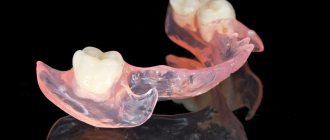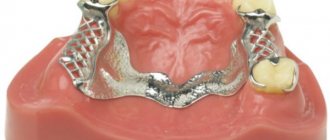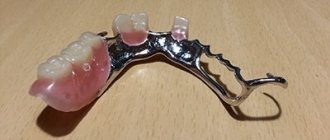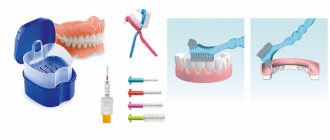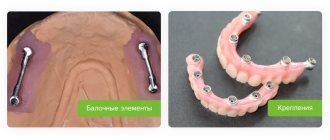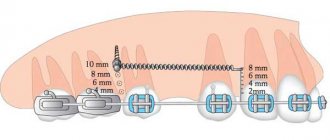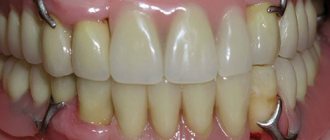A clasp denture is an ideal solution for restoring a number of teeth in the lower jaw, when the patient has retained several of his dental units, but it is not possible to install a full-fledged bridge on them for objective reasons. Also, this design is ideal if the patient does not want (or cannot) install implants, but wants to restore his smile and achieve optimal results for a reasonable budget. Yes, the clasp prosthesis for the lower jaw is a removable model, but it copes with the task perfectly, is a worthy alternative to outdated plate models, and the service life of such a solution is from 10 years.
Removable clasp prosthesis for the lower jaw - consider in detail
Why is a denture for teeth called clasp? The name itself comes from the word “arc”. It is based on a thin cast arc-shaped metal element, onto which a plastic base imitating gum is fixed, as well as artificial crowns - smooth and beautiful teeth. Thanks to the arch, the teeth replacement system is highly durable and reliable, because it will have to be removed and put on at least once a day. As a result, the patient receives a compact, lightweight, comfortable prosthesis for the lower jaw, which is easy to get used to in the first few hours after installation.
How is the prosthesis fixed on the supporting, pre-prepared teeth of the lower jaw? Using hooks or special elements. They are placed on top of the patient’s teeth or on pre-implanted implants. By the way, the prosthesis locks themselves are made not only of a metal alloy, but also of plastic, which is especially important for people with an allergic reaction to metal. But the gums can be made of either nylon or plastic bases (acri-free, quadrotti solutions). When it comes to dental crowns, they are usually made from a plastic material that imitates enamel.
It is important! The specificity of the prosthesis for the lower jaw presupposes that the arch is located on the side of the tongue, that is, where it is not visualized at all. The distance from the arch to the cervical area of the teeth is approximately one millimeter, and a little more is the distance to the bottom of the mouth.
What features do implants have?
Implantation involves installing a special titanium pin (artificial root) into the bone tissue in place of a missing tooth. The implant is the basis for the subsequent manufacture of crowns, bridge structures, and various prostheses.
Over a period of 3 to 6 months, the implants take root (fuse with the surrounding tissues). The implant itself is located under the gum and is not visible. A special transitional part (abutment) and an artificial tooth crown “stick out” from the outside, which is made only after the implant has healed.
This treatment method is effective; implants usually last for several decades. If you follow your doctor's recommendations, the implant can last a lifetime.
Advantages of this type of treatment:
- reliability and longevity;
- adjacent healthy teeth are not ground down;
- after tooth loss, implantation helps to avoid bone tissue deformation and facial features;
- Fixed crowns can be made for implants;
- The function of the tooth is restored completely and allows you to lead a full life.
Like any procedure, implantation has its drawbacks. There are a number of contraindications that make implantation impossible.
Some patients are not satisfied with the fact that before making crowns for implants, it is necessary to wait for their implantation (3-6 months).
Another feature of this procedure is its high cost. It is due to expensive materials, the need to use special tools, and the technical complexity of the installation. Sometimes, installing an implant requires bone tissue augmentation, which further increases the cost and duration of treatment.
Indications for prosthetics
Clasp dentures are installed on the lower jaw if:
- there is an extensive defect - for example, more than two teeth in a row are missing;
- all teeth are completely missing - in this case, to fix the prosthesis, the patient is first implanted with supporting implants;
- the last teeth in the row are missing;
- The patient has chronic periodontitis and there is a need to additionally strengthen the remaining teeth in the row with the help of a prosthesis.
In the meantime, prosthetics with clasp artificial structures are not recommended when:
- there are less than four teeth left in the jaw - unfortunately, this is not enough for a high-quality support base;
- the patient suffers from acute chronic illnesses;
- bone problems have been diagnosed (for example, osteomyelitis of the jaw, as well as osteoporosis);
- a person has an inflamed oral mucosa.
How the system is designed and attached
A prosthesis with telescopic crowns belongs to the clasp type, where the base is a metal frame. The orthopedic system includes 2 components:
- fixed part: represented by a crown resembling a thimble in shape. It is firmly attached to the supporting element using medical cement. Some sources and experts also call it a telescopic system if the structure is attached to implants. However, it is still most correct to consider this term specifically in relation to removable dentures, because a denture on implants is a completely different technology,
- removable part: in fact, the clasp prosthesis itself, into which a second crown with a “pit” is inserted, that is, a recess.
When connecting the parts, the second is put on the first, implementing the principle of a telescope. Thus, the product is firmly fixed. The removable part of the system can be removed from the mouth without much effort.
The process of getting used to the clasp prosthesis - features and nuances
The process of getting used to a clasp denture installed on the lower jaw is not at all quick. At first, the patient may be bothered by excessive salivation and discomfort while chewing food. There may also be speech defects - it is difficult for a person to pronounce hissing and whistling sounds. Also, at first you may feel a slight rubbing of the oral mucosa, but this is normal.
If discomfort when wearing dentures bothers you for more than a week, you need to visit a dentist. The system may need to be adjusted slightly to resolve the discomfort.
Types of telescopic crowns
Telescopic type crowns come in different shapes:
- cylindrical: the walls of the removable and non-removable parts are located parallel. This causes mutual sliding and traction is difficult to maintain. Suitable exclusively for teeth without periodontal pathologies. Extremely difficult to manufacture, therefore rarely used,
- conical: used for any indication for removable prosthetics. Due to the shape, they fit more tightly to each other, while taking off and putting on the prosthesis is quite easy - you don’t have to worry about skewing or jamming. During manufacturing, the individual angle of the cone is taken into account so that the removable part does not fly off randomly. This is possible due to viscous food or tongue, if serious errors were made in the production of the product.
It is not recommended to remove the structure too often, especially since this is not necessary. It is enough to do this once every 2-3 months to perform hygiene procedures.
PROSTHETIC PROSTHETICS WITH 4 STRAUMANN IMPLANTS “teeth in 1 day” - RUB 220,000. until January 15, 2022!
Complex implantation using ProArch technology (Switzerland) with immediate loading on the day of surgery!
Call now or request a call
How much does a clasp prosthesis cost?
The price of lower jaw prosthetics using a clasp design depends on the following factors:
- base and frame material;
- the number of teeth that need to be restored with a prosthesis;
- material for dental crowns.
The average price of a clasp prosthesis is from 32,000 rubles. The price, as a rule, already includes payment for the prosthesis itself, treatment planning, installation of the system, and check-ups with the dentist.
Clasp dentures are an inexpensive and accessible way to restore a smile with a long service life (more than 10 years).
The main indications for the installation of such prostheses
Today, dentists use telescopic crowns if there are the following indications:
- loss of a large number of teeth: the prosthesis can replace several adjacent elements,
- the poor condition of the remaining units: that is, it is obvious that they will soon have to part with. After their loss, the design can be adjusted.
However, installation of such systems is not possible in all cases. Among the contraindications are the inclined position of the teeth, their abrasion of degrees 2 and 3, and individual intolerance to the materials of the product.
Prices for orthopedic structures
| Orthopedics | price, rub. |
| Metal-ceramic structures | |
| Metal-ceramic crown | 8500 from 6500 |
| Solid anatomical crown | 4800 |
| Solid anatomical crown with coating | 5800 |
| Solid thin-walled crown | 3800 |
| Artificial ceramic gums (1 unit) | 2400 |
| Splinting of metal structures (from 8 units) | 12000 |
| Metal-free structures, veneers, inlays | |
| Zirconium dioxide crown | from 14000 |
| All-zirconium anatomical crown | 13200 |
| Telescopic crown | 6400 |
| Plastic crown (permanent) | 3200 |
| Provisional crown (temporary) | 1200 |
| Artificial ceramic gums on zirconium dioxide (1 unit) | 3400 |
| Splinting with zirconium dioxide (from 8 units) | 20000 |
| IPS e.max crown / veneer / inlay with ceramic veneer | from 17200 |
| IPS e.max crown / veneer / inlay with staining | 15600 |
| Implant-supported structures | |
| Metal-ceramic crown supported by an implant | 15000 |
| Solid anatomical crown supported by an implant | 9600 |
| Implant-supported zirconium dioxide crown | 24000 |
| All-zirconium crown supported by an implant | 20000 |
| Metal-ceramic crown with implant support, screw fixation (CAD-CAM) | 21000 |
| Metal-ceramic intermediate tooth with implant support (any fixation) | 12000 |
| Intermediate tooth on zirconium dioxide supported by an implant (any fixation) | 18000 |
| Temporary crown supported by an implant | 2000 |
| Individual titanium abutment made of Pre-milled | 16000 |
| Individual zirconium abutment | 16000 |
| Laboratory abutment | from 6000 to 36000 |
| Abutment key (1 segment) | 2000 |
| Transfer check (1 segment) | 2800 |
| Bonding of crown/abutment (1 unit) | 2000 |
| Removable structures (incl.: prosthesis, consumables, doctor’s work) | |
| Cosmetic prosthesis (up to 3 teeth) | from 5600 |
| Partially removable denture (classic) | from 15000 12900 |
| Complete removable denture (classic) | 16000 13900 |
| Cosmetic prosthesis “Acry-Free” (up to 3 teeth in one segment) | 12000 |
| Partially removable denture "Acry-Free" | from 21000 18000 |
| Complete removable denture "Acry-Free" | from 23000 from 21000 |
| Removable screw-fixed prosthesis supported on implants (temporary structure, without components) | from 58000 |
| Removable denture on locators (ball-shaped locks, without components) | from 58000 |
| Reinforcement of a removable denture (standard) | 2000 |
| Reinforcement of a removable denture (casting) | 4000 |
| Reinforcement of a removable denture (individual) | 8800 |
| Reinforcement of a removable denture (quartz mesh) | 14000 |
| Removable denture on 4 implants | 130000 110000 |
| Removable denture on 6 implants | 180000 160000 |
| Clasp designs | |
| Clasp prosthesis with clasp fixation | from 42000 |
| Clasp prosthesis with locking fixation | from 66000 |
| Clasp denture on telescopic crowns (at least 2 supports) | from 30000 from 28000 |
| Clasp prosthesis made of thermoplastic Acetal | from 30000 |
| Additional support in the locking clasp | from 12000 |
| Additional support in the clasp on telescopes | from 14000 |
| Cleaning and polishing the clasp denture | 6000 |
| Additional types of work | |
| Auxiliary model | 1200 |
| Diagnostic model | from 1500 |
| Collapsible model | 2800 |
| Fixation of the crown | 1000 |
| Wax modeling (1 unit) | 1600 |
| Wax template | 1400 |
| Individual spoon | 2400 |
| Laboratory pin insert | 3200 |
| Additional pin for laboratory pin placement | 1200 |
| Application of opaque | 800 |
| Sputtering | 1200 |
| Casting (clinical) | 800 |
| Gum mask (1 unit) | 1600 |
| Taking one impression A silicone (1 jaw) | 1000 |
| Taking one impression with silicone (1 jaw) | 600 |
| Repairing and cleaning dentures | |
| Relining the Acrylic prosthesis | 4000 |
| Relining the Acry-Free prosthesis | from 8000 |
| Repairing a prosthesis | from 3200 |
| Repairing a clasp denture | from 8000 |
| Tooth welding (1 unit) | from 2400 |
| Welding the clasp (1 unit) | from 2800 |
| Cleaning and polishing the denture | 3200 |
| Cleaning and polishing the clasp denture | 8000 |
| Repairing, cleaning and polishing of the prosthesis (complex) | from 5200 |
| Mouth guards | |
| Mouth guard night/retention | 5600 |
| Whitening tray | 6800 |
| Sports mouthguard 3-layer | 18000 |
Contraindications
The use of clasp splinting devices is contraindicated:
with unsatisfactory oral hygiene;- during pregnancy;
- for acute inflammatory lesions of the mucous membranes and gums;
- in the period after radiation therapy sessions;
- for oncology;
- for mental illness;
- for severe heart pathologies;
- with pronounced disturbances in the structure of bone tissue;
- with individual intolerance to metal;
- if the supporting teeth do not have the required height;
- in case of unsatisfactory condition of support units.
The doctor makes a decision on the possibility of prosthetics using a splinting clasp device after an in-person examination of the patient’s oral cavity and a series of diagnostic techniques.
Who is it suitable for?
QuattroTi prosthetics are indicated in the following cases:
- if several teeth are missing in the dentition;
- as a temporary option before implantation;
- after treatment for gingivitis or periodontitis;
- with low incisor height;
- if the patient has sensitive or weak gums;
- there is no possibility of installing a classic clasp prosthesis;
- if the patient’s activity is associated with the likelihood of jaw injury;
- when the patient does not want to grind down the supporting teeth to install crowns.
However, there are certain limitations. The number of remaining teeth must correspond to the possibilities of installing the Quadrotti clasp denture. In the lower jaw, 4 supporting teeth are sufficient, and in the upper jaw there should be at least 6 or 7. Moreover, they should be located on both sides of the jaw.
There are also certain requirements for preserved teeth. They should not be mobile; it is also important that at the end of the dentition at least 1 tooth on each side is preserved. If the dentition has end defects, Quadrotti dentures cannot be fixed well - they will fall out when speaking or while eating.
In addition, there are contraindications:
- the presence of chronic periodontitis or other inflammatory diseases;
- high tissue atrophy;
- complete edentia;
- deviations in the state of the nervous system.
Temporary contraindications include caries. After treatment with QuattroTi, prosthetics become possible.
Why choose a telescopic system
Among the undoubted advantages of such systems, experts note the following points:
- reliable fastening: the telescopic crown ensures complete immobility of the structure and eliminates the possibility of its falling out,
- uniform distribution of pressure on the supporting units when chewing: this prevents injury to the gums and has a good effect on periodontal tissues,
- accessibility of the spaces between the teeth when removing the prosthesis: allows you to fully perform hygiene procedures,
- the possibility of adjusting the products: this may be necessary if other teeth are lost,
- absolute aesthetics: thanks to the hidden fastening system, the prosthesis looks as natural as possible,
- strength: do not have open moving elements that could be broken.
Separately, it is worth mentioning the comfort of wearing such structures. They do not put pressure on the root of the tongue, so they do not cause a gag reflex. Dryness in the mouth is also not a threat, since the products do not close the salivary ducts. Another plus is the absence of a negative impact on diction.
Like any orthopedic solutions, telescopic systems are not without their drawbacks. The main one is the gradual atrophy of the jaw bone, which ceases to receive a full chewing load. This is a common disadvantage, characteristic of all prosthetic products.
Another disadvantage of telescopic structures is their high cost compared to other removable dentures. This is explained by the need to make 2 crowns for each abutment tooth. The exact amount will depend on the material of the product and the number of crowns.
Content:
- Pros and cons of splinting clasp devices
- Distinctive features of clasp splinting developments
- Indications for installation
- Contraindications
- Manufacturing
- Rules for caring for artificial teeth
The optimal solution for tooth decay and loss is implantation.
But not all dental patients can afford this option. It is inaccessible to some due to contraindications and health problems, to others due to its high cost. A good alternative to implants are splinting clasp dentures. They are metal frames on which artificial teeth and gums are placed. The peculiarity of structures of this type is that they not only restore the integrity of the dentition, but also prevent further loosening of the movable units. They are usually used for increased tooth wear, pathological deep bite, and periodontal diseases.
Manufacturing stages
QuattroTi prosthetics occurs in several stages, which take approximately 2 weeks.
1. Inspection and preparation.
Sanitation is carried out, caries is treated, plaque and tartar are removed. The material and color scheme are selected;
2. Making a prosthesis.
After making an impression, dental models are formed in a dental laboratory, the prosthesis is ground and polished;
3. Installation of the prosthesis.
After fitting and fixation, the prosthesis is finally installed, and the patient receives recommendations on the rules of its use and care.
How to care for dentures on “telescopes”
The products can be worn around the clock; they do not need to be removed at night. Caring for a prosthesis is simple, you just need to follow a number of rules:
- the removable part is periodically removed from the oral cavity and placed for disinfection in a soda-saline solution for 10-15 minutes. You can also use special solutions that are sold in pharmacies. It is important to understand that such a prosthesis is not completely removable, but conditionally removable, that is, it does not need to be removed too often; the entire system can be “lost”
- In normal times, hygiene procedures are carried out using the usual means: only pastes with abrasive particles that can damage the surface of the product are prohibited. It is recommended to use an irrigator, which will perfectly remove product residues from under the prosthesis,
- If the prosthesis needs to be removed for a long period of time, it should be cleaned, dried and stored in a plastic container at room temperature. Do not place the product in the refrigerator or keep it near a heat source - this will lead to its deformation.
Every six months it is necessary to visit the dentist in order to be able to identify possible problems in time and correct the design.
“I used an acrylic prosthesis for two years - during this time I experienced a lot of inconvenience, and especially when eating. In addition, the rigidity of acrylic constantly interfered. On the advice of the doctor, I installed a clasp prosthesis on telescopic crowns. I felt the difference immediately. I got used to it very quickly and now I hardly feel it. Almost like natural teeth!” Valentina, from correspondence on the dental forum
REPROSTHETICS WITH ACRYLIC PROSTHETICS - RUB 150,000. instead of 180,000 rub. until January 15, 2022!
Re-prosthetics with an acrylic bridge on a metal frame (all included) up to 12 units.
Call now or request a call
A telescopic dental crown and denture can theoretically last up to 10 years. However, practice shows that the actual period reaches a maximum of 4 years. After this time, the adhesive force of the crowns dries up, and they no longer fit tightly to each other.

